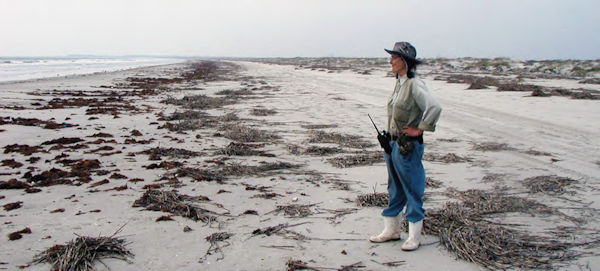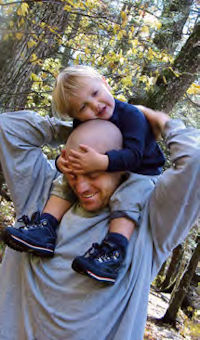SEJournal Online is the digital news magazine of the Society of Environmental Journalists. Learn more about SEJournal Online, including submission, subscription and advertising information.
Between the Lines
Rarely does a writer get so deeply into the heart of his or her subject while also avoiding the pitfalls of sentimentality. So began the judges’ comments for “Untamed: The Wildest Woman in America and the Fight for Cumberland Island,” winner of SEJ’s 2015 Rachel Carson Environment Book Award. The book’s author, Will Harlan, spent 19 years developing a bold, unflinching portrayal of Cumberland Island, Ga.’s most ardent defender, the brilliant-yet-eccentric Carol Ruckdeschel. For the latest edition of SEJournal’s Between the Lines author Q & A, Harlan spoke with our book editor, Tom Henry, one of the judges who described Harlan’s biography as “one gorgeous book, a testament not only to Will Harlan’s obvious writing chops but also what the best in journalism is all about, the passion to dig and go beyond the obvious.”
 |
| Carol Ruckdeschel on the beach at Cumberland Island National Seashore in Georgia. Photo by Will Harlan |
SEJournal: First, what gave you the inspiration to do a book on Carol Ruckdeschel? Was it immediately evident she would yield enough material for a book or did that thought emerge later?
Will Harlan: I didn’t set out to write a book about Carol. I just wanted to learn as much as I could from her. When I first met Carol, I was a 21-year-old, starry-eyed park service ranger working on Cumberland Island for the summer. I was simply planning to soak in the sand and sun for a few months. Then I crossed paths with Carol on the beach, carving up a dead sea turtle carcass, and I was enthralled.
The Park Service and island residents had vilified Carol as “the wicked witch of the wilderness,” a coldhearted, reclusive, mean-spirited hermit. But the woman I met on the beach that morning was exactly the opposite. She was warm, animated — hell, she was downright chatty. She invited me over to examine a turtle carcass and asked me to hold its intestines while she split them open to reveal the turtle’s most recent meal. Carol was unraveling a turtle murder mystery, and the gut contents of the turtles were important clues.
I was hooked. I shadowed her for the next decade, mainly because I was fascinated by her life and her work. Only much later did I think about writing a book.
SEJournal: “Untamed” is a beautifully written, unflinching portrayal of Ruckdeschel that also doesn’t get bogged down by sentimentality. What challenges did you have expressing the passion and zeal she has for nature, without making this just another book about activism?
Harlan: Carol is a lot like the turtles she studies: Beneath her hard, tough shell, she is soft and vulnerable. She makes mistakes and gets her heart broken like the rest of us. Carol is so much more than an activist. She is complicated, kaleidoscopic and sometimes contradictory. I wanted to capture her complexity, because she embodies so many of the tensions we all face. Once readers could relate to her as a person, they could more readily step inside her muddy boots and experience her dangers, decisions and discoveries.
SEJournal: What did you learn from the nuts-and-bolts process of doing this book, i.e., organization? What surprises did you encounter in doing your research? What changed you as a writer, a thinker and as an observer of humanity’s interaction with nature?
 |
| Will Harlan and son. |
Harlan: This was my first book, and I learned a ton. Probably the biggest lesson was that a book is an ecosystem. I thought I could be a lone wolf writing my book alone. It turned out that I depended on the insights of countless people who made the book much better and more complete. It evolved a life of its own. Similarly, I think Carol discovers — after years of going it alone — that she needs others too.
SEJournal: She’s an amazing character, but how did you convince her to let you follow her all of those years and reveal so much about her life?
Harlan: I just kept hanging around. I stuck with her — and the island. I guess I stuck with it long enough that she began to trust me. Carol also knew that I loved the island almost as much as she did. I proposed to my wife on Cumberland, etching my proposal into the sand. I spent every break and every long weekend there. The island had given me so much; the least I could do was try to tell its story as best I could.
Carol also wanted the island’s story to be told — although initially she didn’t want her life story to be included. I wrote a few newspaper and magazine features about the environmental politics of Cumberland, but honestly they were pretty boring and barely made a splash. I finally realized that Carol’s story was essential to emotionally connect readers to the island. She was very reluctant at first, but eventually she relented. As she put it, “Fine. I will prostitute myself for the island if that’s what it takes. I’ll whore myself out for the wilderness.” That’s basically how she sees the book: prostitution.
SEJournal: What advice would you give writers who think they have a great person to profile and want to — as you say — rip open scab wounds, splay open innards and dissect someone’s life?
Harlan: Be patient. Be honest with your subject and yourself. And be prepared to spend a lot of time with that person. I tried writing this book ten years ago, but I didn’t know Carol well enough then.
SEJournal: What lessons did this book give you about trust between writer and subject?
Harlan: Carol didn’t like many parts of the book, especially sections where her opponents make false accusations about her and describe her horribly — “a manipulative, murderous whore who slept her way onto the island,” and “a backstabbing bitch who cares more about animals than people.” She could not understand why I would promulgate these demonstrably untrue claims. But I told her from the start that I was telling her whole story — including the rumors that still circulate today about her. I had to show the entire spectrum of opinions about her, even if some of them were hurtful.
Carol also didn’t want to relive especially painful parts of her life — like the shooting [details of a self-defense shooting of a man who threatened her are in the book]. “What does this personal incident have to do with the island or sea turtles?” she asked. My intent was not to sensationalize her life on the island by describing the gory details of this deadly encounter. Rather, it was to tell exactly what had happened — supported by facts, eyewitnesses and testimonies from the police reports and court proceedings — so that there was an accurate account that could hopefully dispel many of the rumors.
Sure, writing a book is a ton of work. But in the end, it was Carol who made the biggest sacrifices and took the biggest risks. I didn’t fully appreciate that at the outset. It took a lot of courage for her to open up her life and let me dissect it.
 |
| A sea turtle hatchling reaches the water’s edge at Cumberland Island National Seashore. Photo by Will Harlan |
SEJournal: How did you sell your publisher on the idea that Carol Ruckdeschel’s story was truly unique, that you weren’t offering up just another tale of a “dirt poor naturalist” whom many people see as misfits?
Harlan: Fortunately, it didn’t take much convincing. Carol’s life made my job easy. She had devoted 44 years to dissecting dead sea turtles every single day, wading into alligator dens and defending the island’s wildlife — often by putting herself in the line of fire to stop the slaughter. She also shot and killed a stalking ex-lover threatening to kill her. She built her own ramshackle cabin and lives authentically and self-sufficiently.
One of the many qualities that sets Carol apart is her scientific acumen. Even though she only has a high school diploma, she knows more about sea turtles than most Ph.D. biologists and has spent more time in the field with turtles than any person alive today. She is a data-driven, detail-oriented scientist who has the firsthand, field-tested research to back up her assertions.
SEJournal: Do you have other book projects on the horizon? If so, what?
Harlan: This book took me nearly two decades. I figure I have a few years to figure out the next project. Sadly, they don’t make 'em like Carol anymore. It will be tough to find someone who lives such a complex, controversial and colorful life dedicated so completely to a higher cause.
* From the quarterly newsletter SEJournal, Winter 2015/2016. Each new issue of SEJournal is available to members and subscribers only; find subscription information here or learn how to join SEJ. Past issues are archived for the public here.












 Advertisement
Advertisement 



